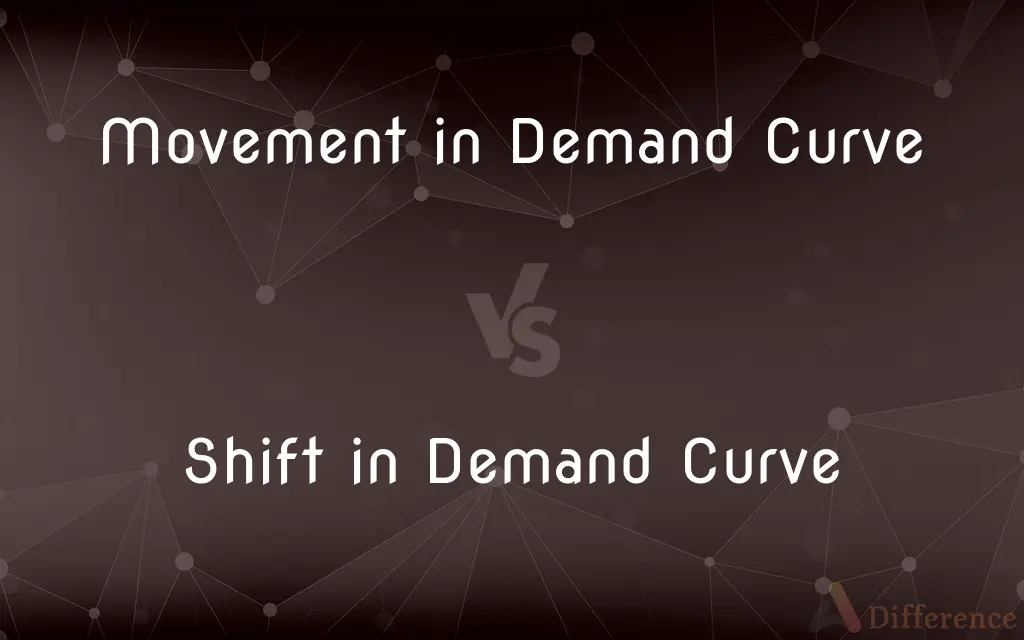Movement in Demand Curve vs. Shift in Demand Curve — What's the Difference?
Edited by Tayyaba Rehman — By Fiza Rafique — Published on December 28, 2023
Movement in Demand Curve refers to a change in quantity demanded due to price variation, while Shift in Demand Curve indicates a change in overall demand due to non-price factors.

Difference Between Movement in Demand Curve and Shift in Demand Curve
Table of Contents
ADVERTISEMENT
Key Differences
In the landscape of economics, understanding the concepts of Movement in Demand Curve and Shift in Demand Curve is pivotal. Movement in Demand Curve pertains to the rise or decline in quantity demanded as a direct result of changes in the product's price. Such movements are either upward or downward on the same curve. In contrast, Shift in Demand Curve reflects a change in the entire demand due to factors other than price, leading to a new curve either to the right or left of the original.
Movement in Demand Curve is a simple response to price alterations. For instance, if the price of a product drops, consumers might buy more, resulting in a downward movement on the demand curve. Conversely, Shift in Demand Curve occurs when other determinants, like consumer income, preferences, or the prices of related goods, alter the overall demand. Such shifts can either increase or decrease demand irrespective of the current price.
For visual clarity, consider plotting price against quantity on a graph. Movement in Demand Curve would involve traveling up or down that same curve, denoting price as the sole factor for change. However, Shift in Demand Curve would require drawing an entirely new curve, parallel to the first, highlighting that something more than just price is at play.
Summing up, while Movement in Demand Curve portrays how consumers react to price changes of a good, Shift in Demand Curve delves deeper, shedding light on how external elements can redefine the entire demand landscape.
Comparison Chart
Cause
Price changes of the good itself.
Factors other than price (e.g., income, tastes).
ADVERTISEMENT
Direction
Upward or downward on the same curve.
Entire curve moves either to the right (increase) or left (decrease).
Indicates
Change in quantity demanded.
Change in overall demand.
Example Catalyst
A product going on sale.
An increase in consumer income or a change in preferences.
Graphical Representation
Movement along the curve.
Drawing a completely new curve parallel to the original.
Compare with Definitions
Movement in Demand Curve
Movement in Demand Curve directly correlates with price elasticity.
The elastic nature of luxury goods often showcases evident Movement in Demand Curve upon price adjustments.
Shift in Demand Curve
Shift in Demand Curve can be either right (increase) or left (decrease).
The launch of a superior tech gadget resulted in a leftward Shift in Demand Curve for older models.
Movement in Demand Curve
Movement in Demand Curve represents quantity changes due to price shifts.
When coffee prices fell, there was a downward Movement in Demand Curve as consumers bought more.
Shift in Demand Curve
Shift in Demand Curve indicates changes in demand due to non-price determinants.
A trending diet favoring avocados caused a rightward Shift in Demand Curve.
Movement in Demand Curve
Movement in Demand Curve remains on the same curve.
The surge in ice-cream sales during the discount season indicated a Movement in Demand Curve.
Shift in Demand Curve
Shift in Demand Curve showcases underlying factors influencing demand.
Health concerns about soda led to a distinct leftward Shift in Demand Curve.
Movement in Demand Curve
Movement in Demand Curve signifies consumers' response to varying prices.
Higher ticket prices caused an upward Movement in Demand Curve with fewer people attending.
Shift in Demand Curve
Shift in Demand Curve results in a completely new curve.
A rise in disposable income among consumers led to a Shift in Demand Curve for luxury cars.
Movement in Demand Curve
Movement in Demand Curve is either upward or downward.
Reduced prices of eBooks led to a noticeable downward Movement in Demand Curve.
Shift in Demand Curve
Shift in Demand Curve goes beyond mere price considerations.
Environmental awareness campaigns caused a rightward Shift in Demand Curve for electric vehicles.
Common Curiosities
How does Shift in Demand Curve differ from Movement in Demand Curve?
Shift in Demand Curve reflects changes in overall demand due to non-price factors, whereas Movement in Demand Curve is due to price changes alone.
What is Movement in Demand Curve?
Movement in Demand Curve is a change in quantity demanded caused by the product's price changes.
What factors might cause a Shift in Demand Curve?
Factors like changes in income, consumer preferences, or prices of related goods can cause a Shift in Demand Curve.
Is Movement in Demand Curve always along the same curve?
Yes, Movement in Demand Curve involves traveling up or down the same demand curve.
Can both Movement in Demand Curve and Shift in Demand Curve occur simultaneously?
Yes, price changes can lead to Movement in Demand Curve, while other factors can cause a Shift in Demand Curve concurrently.
Does a leftward Shift in Demand Curve imply reduced demand?
Yes, a leftward Shift in Demand Curve represents a decrease in overall demand.
Can consumer expectations influence a Shift in Demand Curve?
Yes, if consumers expect future price hikes or shortages, it might cause a current rightward Shift in Demand Curve.
Do external events like natural disasters influence Shift in Demand Curve?
Yes, such events can change consumer preferences or incomes, leading to a Shift in Demand Curve.
What direction does the curve move in a rightward Shift in Demand Curve?
A rightward Shift in Demand Curve indicates an increase in overall demand.
Is Movement in Demand Curve only downwards with a price drop?
No, Movement in Demand Curve can be upwards with a price rise, leading to decreased quantity demanded.
Is Movement in Demand Curve always vertical?
It's not vertical but along the curve; it can be either upward or downward based on price changes.
Can a change in the price of a related good cause a Shift in Demand Curve?
Yes, for example, a price increase in beef might cause a rightward Shift in Demand Curve for chicken as a substitute.
How is elasticity related to Movement in Demand Curve?
Elasticity measures the responsiveness of quantity demanded to price changes, which is depicted as Movement in Demand Curve.
Which shows a temporary change, Movement in Demand Curve or Shift in Demand Curve?
Movement in Demand Curve typically shows a temporary response to price changes, while Shift in Demand Curve indicates more fundamental changes in demand.
Can government policies cause a Shift in Demand Curve?
Absolutely. Policies, like taxes or subsidies, can affect consumer income or preferences, causing a Shift in Demand Curve.
Share Your Discovery

Previous Comparison
East African Facial Features vs. West African Facial Features
Next Comparison
Investment Bank vs. Commercial BankAuthor Spotlight
Written by
Fiza RafiqueFiza Rafique is a skilled content writer at AskDifference.com, where she meticulously refines and enhances written pieces. Drawing from her vast editorial expertise, Fiza ensures clarity, accuracy, and precision in every article. Passionate about language, she continually seeks to elevate the quality of content for readers worldwide.
Edited by
Tayyaba RehmanTayyaba Rehman is a distinguished writer, currently serving as a primary contributor to askdifference.com. As a researcher in semantics and etymology, Tayyaba's passion for the complexity of languages and their distinctions has found a perfect home on the platform. Tayyaba delves into the intricacies of language, distinguishing between commonly confused words and phrases, thereby providing clarity for readers worldwide.















































